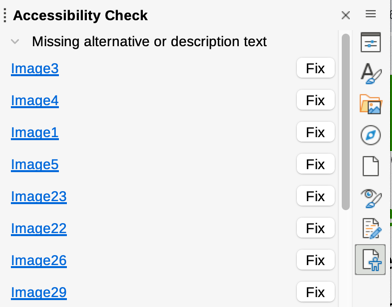

Writer Guide 24.2
Chapter 7, Printing and Publishing
This document is Copyright © 2024 by the LibreOffice Documentation Team. Contributors are listed below. This document may be distributed and/or modified under the terms of either the GNU General Public License (https://www.gnu.org/licenses/gpl.html), version 3 or later, or the Creative Commons Attribution License (https://creativecommons.org/licenses/by/4.0/), version 4.0 or later. All trademarks within this guide belong to their legitimate owners.
To this edition
|
Jean Hollis Weber |
|
|
To previous editions
|
Jean Hollis Weber |
Kees Kriek |
John A Smith |
|
Bruce Byfield |
Gillian Polack |
Dante Legaspi |
|
Ron Faile Jr. |
|
|
Please direct any comments or suggestions about this document to the Documentation Team Forum at https://community.documentfoundation.org/c/documentation/loguides/ (registration is required) or send an email to: loguides@community.documentfoundation.org.
Note
Everything sent to a forum, including email addresses and any other personal information that is written in the message, is publicly archived and cannot be deleted. Emails sent to the forum are moderated.
Published February 2024. Based on LibreOffice 24.2 Community.Other versions of LibreOffice may differ in appearance and functionality.
Some keystrokes and menu items are different on macOS from those used in Windows and Linux. The table below gives some common substitutions used in this document. For a detailed list, see LibreOffice Help.
|
Windows or Linux |
macOS equivalent |
Effect |
|
Tools > Options menu selection |
LibreOffice > Preferences |
Access setup options |
|
Right-click |
Control+click or right-click depending on computer setup |
Open a context menu |
|
Ctrl (Control) |
⌘ (Command) |
Used with other keys |
|
Alt |
⌥ (Option) or Alt |
Used with other keys |
|
F11 |
⌘+T |
Open Styles deck in Sidebar |
This chapter describes features in LibreOffice Writer related to printing, publishing, and distribution of documents:
Printing, including documents, envelopes, and labels
Exporting to PDF, EPUB, and other formats
Emailing documents
Digital signing of documents
Removing personal data before distributing documents
Redaction
Accessibility checking of a document before publication
If the Print Directly icon is visible on the Standard toolbar, you can click it to print the entire document using the current default print settings. If the icon is not visible, you can make it visible by right-clicking on the toolbar, pointing to Visible Buttons, and selecting Print Directly.
To specify the default printer, choose File > Printer Settings on the Menu bar. The Printer Setup dialog (Figure 1) opens. To access other printing options, click the Options button on the Printer Setup dialog. The same default options are available through Tools > Options > LibreOffice Writer > Print, and more general print options through Tools > Options > LibreOffice > Print. See Chapter 20, Customizing Writer, for more information.
Figure 1: Printer Setup dialog
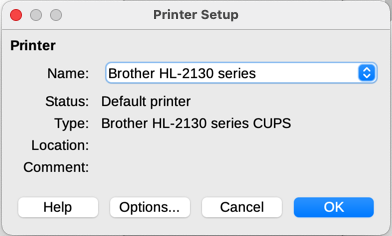
For more control over printing, use the Print dialog (File > Print, Ctrl+P (⌘+P for macOS), or the Print icon on the Standard toolbar). The appearance of the Print dialog is different on Windows and Linux than it is on macOS, so they are described separately in this chapter.
On Windows and Linux, the Print dialog (Figure 2) has two tabs, on which you can choose a range of options, as described in the following sections. The appearance of this dialog may vary slightly depending on the operating system in use.
On the General tab of the Print dialog, you can choose:
The printer, from the list of available printers.
Which pages to print, the number of copies to print, and whether to collate multiple copies (Range and copies section).
Paper size and print orientation (Page Layout section).
How many pages to print on one sheet of paper and whether to draw a border around each page (Page Layout section).
Whether to print a brochure (see page 1).
Whether to print in reverse page order (useful on some printers to make the pages come out in page order).
Figure 2: The Print dialog on Windows and Linux
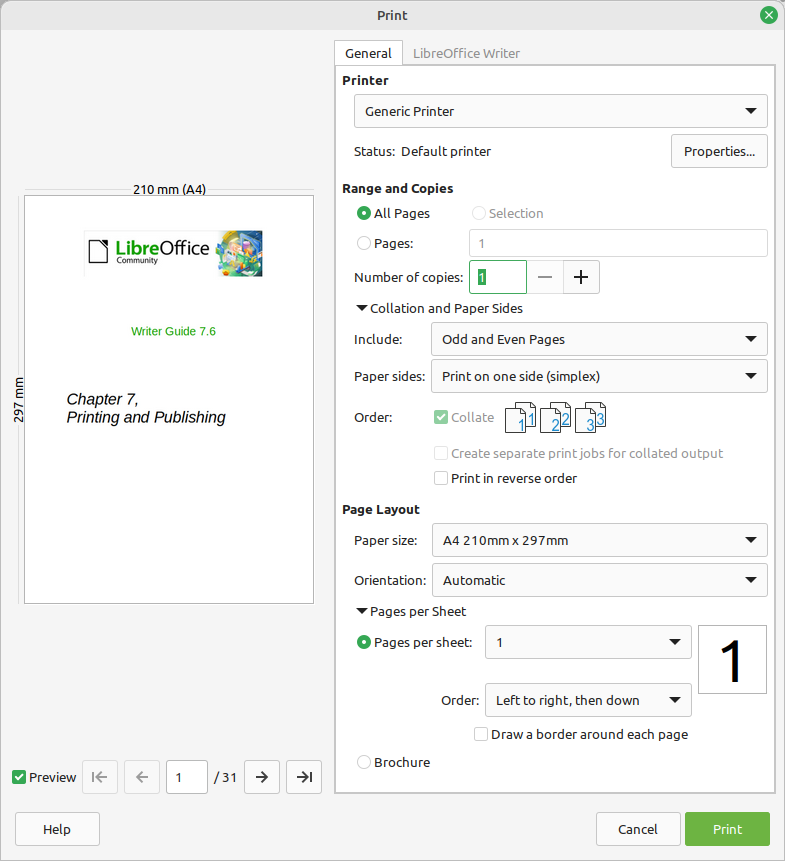
In the Printer section of the General tab, click the Properties button to display the selected printer’s properties dialog where you can choose portrait or landscape orientation, which paper tray to use, and the paper size to print on.
Click Collation and Paper Sides at the bottom of the Range and Copies section of the General tab to choose whether to create separate print jobs for collated output, instead of one print job containing all the collated pages (not relevant if only one copy of a document is printed).
In addition to printing a full document, you can choose to print individual pages, a ranges of pages, or a selection from a document.
Individual page
1) In the Print dialog, in the Range and Copies section, select the Pages option. The text box shows the current page number.
2) Enter the page number of the page you want to print. The preview box on the left changes to show the selected page.
Range of pages
1) In the Print dialog, in the Range and Copies section, select the Pages option.
2) Enter the page numbers of the pages to print (for example, 1–4 or 1,3,7,11 or a combination).
Selection of text or graphics
1) In the document, select the material to print, then open the Print dialog.
2) In the Range and Copies section of the Print dialog, the Selection option is now active and selected and the preview box shows the selected material (Figure 3).
Figure 3: Printing a selection of text in Windows and Linux
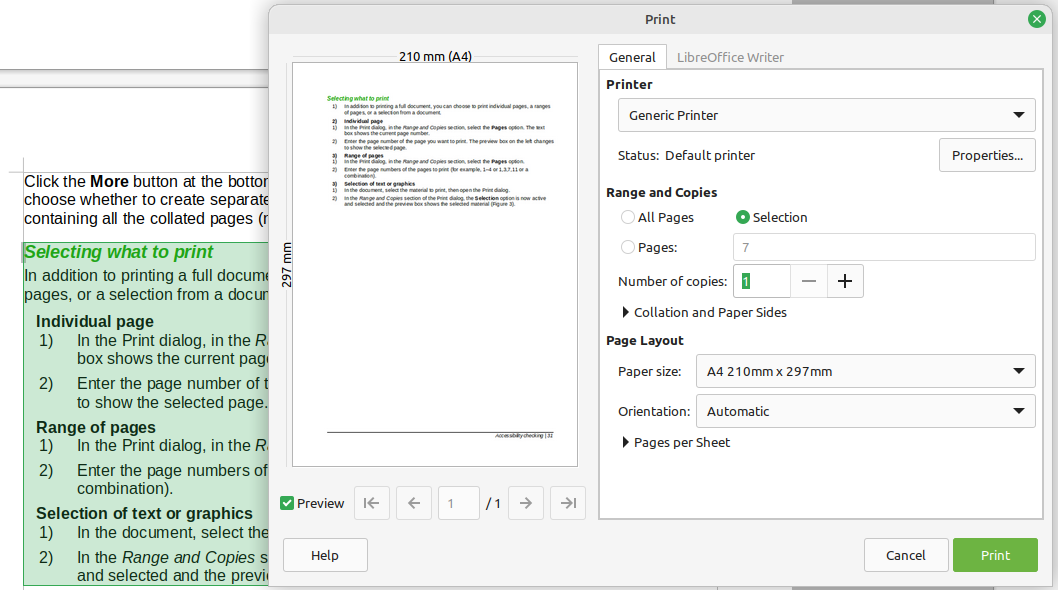
On the LibreOffice Writer tab (Figure 4) you can choose to print a subset of contents (for example, images or hidden text), print text in black (even if a color is defined for the text), whether to print automatically inserted blank pages, and whether and where to print any comments that are in the document.
Some selections may not be available all the time. For example, if the document contains no comments, the Comments drop-down list is disabled.
Figure 4: LibreOffice Writer tab of Print dialog
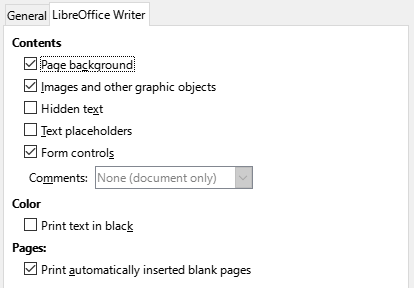
The LibreOffice Print dialog in macOS has several pages, described in the following sections. These pages are listed in a drop-down menu below the upper part of the dialog (Figure 5). Its appearance and layout on macOS 13 (Ventura) vary a bit from macOS 12 (Monterey) and earlier. The examples here are from macOS 12.
Figure 5: Pages of the Print dialog on macOS 12
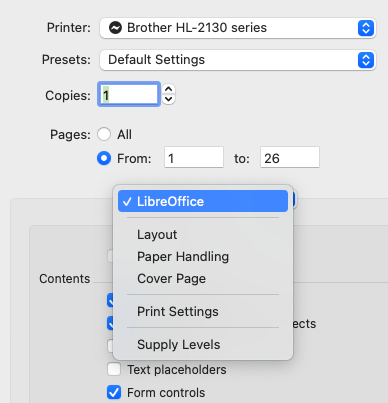
In the upper part of the Print dialog on macOS (Figure 5), you can choose:
The printer, from the list of available printers
The number of copies to print
Which pages to print: all, or a continuous range of pages; for a discontinuous range of pages, see the Pages section under LibreOffice Writer in the lower part of the dialog.
On the LibreOffice Writer page of the Print dialog on macOS (Figure 6), you can choose:
What contents to print: page background, images and other graphic objects, hidden text, text placeholders, and form controls.
Whether to print text in black, instead of any colors defined in the document.
Whether to print automatically inserted blank pages, a selection of pages, or a selection of contents.
Whether and where to print comments.
Whether to print a brochure (see page 1).
Some selections may not be available all the time. For example, if the document contains no comments, the Comments drop-down list is disabled.
Figure 6: The LibreOffice Writer page of the Print dialog on macOS 12
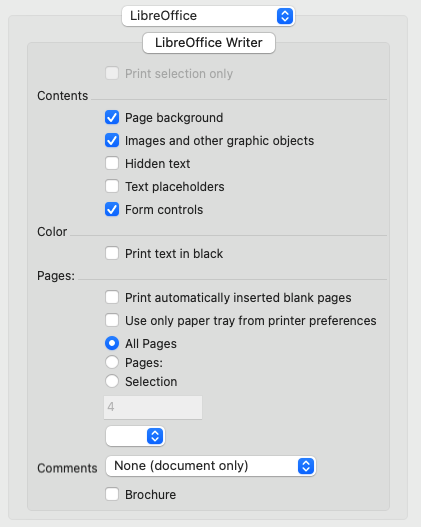
In addition to printing a full document, you can choose to print individual pages, a range of pages, or a selection from a document.
Individual page
Consecutive range of pages
Non-consecutive range of pages
Selection of text or graphics
Figure 7: Printing a selection of text on macOS 12
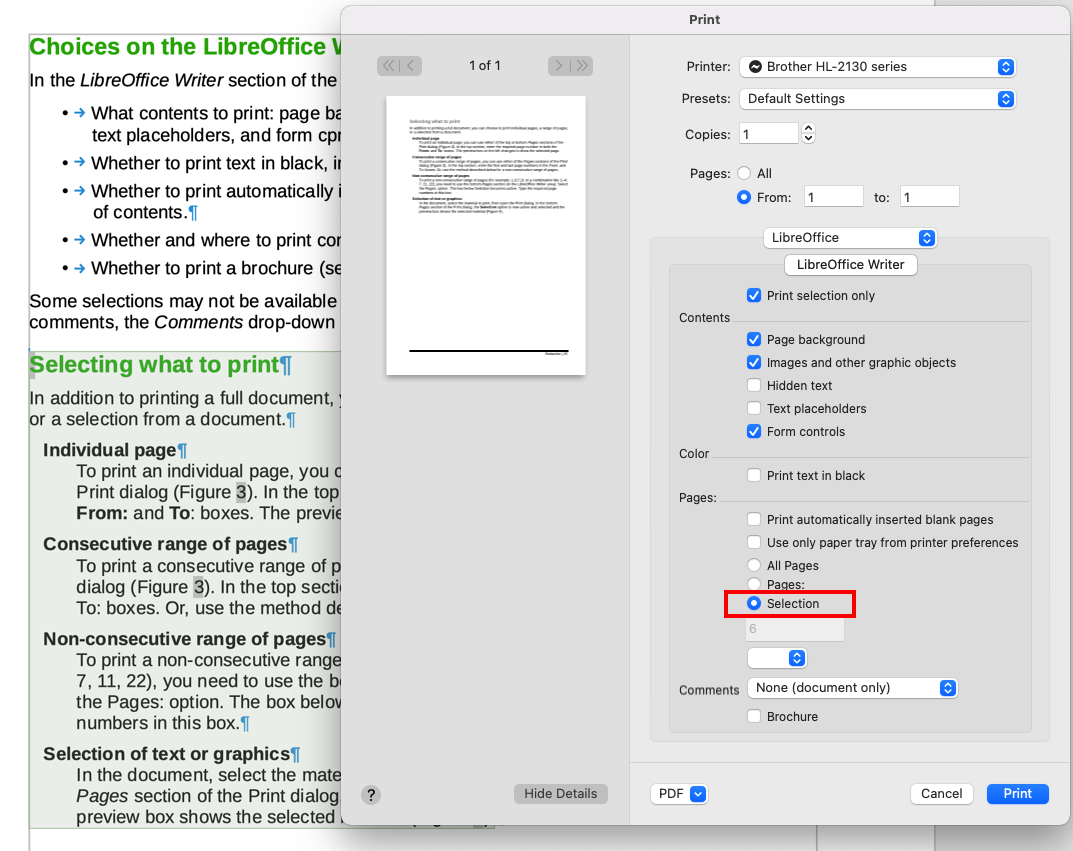
You can print multiple pages of a document on one sheet of paper. To do this:
[Windows or Linux] On the Page Layout section of the General tab of the Print dialog (Figure 8), click Pages per Sheet and select from the Pages per sheet drop-down list the number of pages to print per sheet of paper.
[macOS] Go to the Layout page (Figure 9) of the Print dialog and select from the Pages per Sheet drop-down list the number of pages to print per sheet of paper.
When printing more than two pages per sheet, you can choose the order in which they are printed across and down the paper. The preview panel on the left of the Print dialog changes to show how the printed document will look.
Figure 8: Print order choices on Windows and Linux
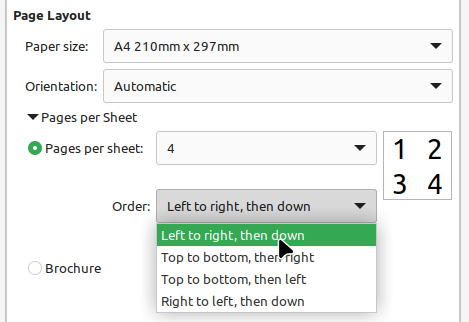
Figure 9: Print order choices on macOS 12
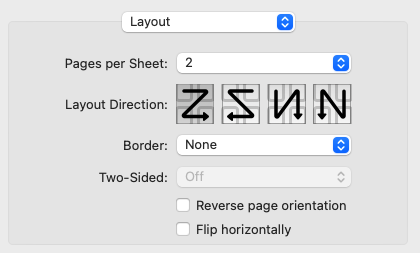
In Writer, you can print a document with two pages on each side of a sheet of paper, arranged so that when the printed pages are folded in half, the pages are in the correct order to form a booklet or brochure.
Tip
Plan your document so it will look good when printed half size; choose appropriate margins, font sizes, and so on. You may need to experiment.
The process for printing a brochure is the same for all operating systems, but the settings are found in different places.
Figure 10: Settings for printing a brochure using Windows or Linux
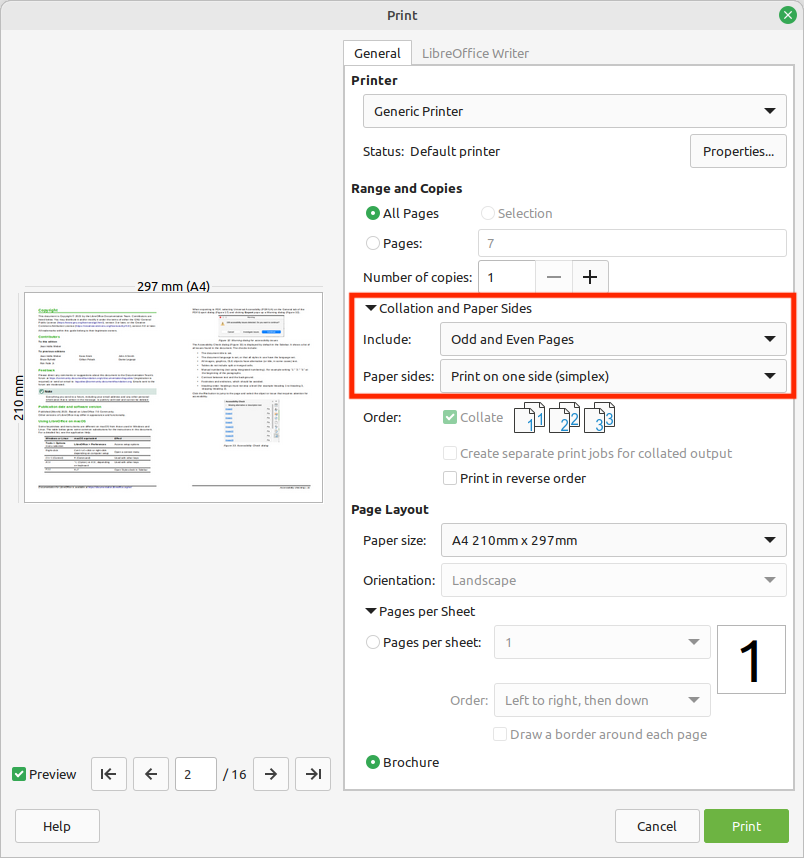
To print a brochure on a single-sided (simplex) printer:
1) [Windows and Linux] In the Page Layout section of the General tab of the Print dialog, select Brochure near the bottom (Figure 10).
2) If Asian or CTL is selected in your language settings, the Print dialog will include a drop-down menu near the Brochure option (not shown in Figure 10). This list provides Left-to-right script and Right-to-left script options. Select the required setting.
3) [Windows and Linux] In the Range and Copies section of the General tab of the Print dialog, under Collation and Paper Sides—Include, select Even pages.
4) Click Print. Take the printed pages out of the printer and put them back into the printer in the correct orientation to print on the blank side. You may need to experiment to find the correct arrangement for your printer.
5) [Windows and Linux] In the Range and Copies section of the General tab of the Print dialog, under Collation and Paper Sides—Include, select Odd pages.
6) Click Print.
Tip
If your printer can print double-sided (duplex) automatically, choose Odd and Even Pages in step 3 and skip steps 4 and 5.
Figure 11: Settings for printing a brochure using macOS
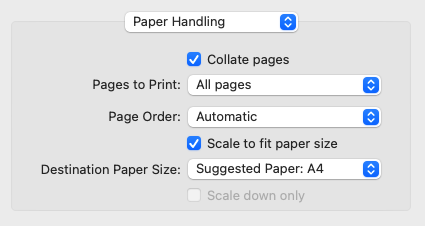
You may wish to print documents in black and white on a color printer. Several choices are available.
Note
Some color printers may print in color regardless of the settings you choose.
[Windows and Linux] For one document, change the printer settings to print in black and white or grayscale:
1) On the Print dialog, click Properties to open the Properties dialog for the printer. The available choices vary from one printer to another, but you should find options for the color settings. See your printer’s help or user manual for more information.
2) The choices for color might include black and white or grayscale. Choose grayscale.
3) Click OK to confirm your choice and return to the Print dialog.
4) Click Print to print the document.
[macOS] For one document, change the Color setting on the LibreOffice Writer page of the Print dialog (Figure 6):
1) In the Color section, select Print text in black.
2) Click Print to print the document.
[All] To print all color text and images as grayscale, change the LibreOffice settings:
1) Choose Tools > Options > LibreOffice > Print [macOS: LibreOffice > Preferences > LibreOffice > Print].
2) Select the Convert colors to grayscale option. Click OK to save the change.
[All] To print all color text as black, and all images as grayscale, change the LibreOffice Writer settings:
1) Choose Tools > Options > LibreOffice Writer > Print [macOS: LibreOffice > Preferences > LibreOffice Writer > Print].
2) Under Contents, select the Print text in black option. Click OK to save the change.
The normal page view in Writer shows what each page will look like when printed; you can edit the pages in that view. If you are designing a document to be printed double-sided, you may want to see what facing pages look like. Writer provides two ways to do this:
View Layout (editable view): use the Book View button on the status bar and (usually) zoom out.
Figure 12: Book view icon on Status bar

Print Preview (read-only view).
To use Print Preview:
1) Choose File > Print Preview on the Menu bar, or click the Toggle Print Preview icon on the Standard toolbar, or press Ctrl+Shift+O. Writer now displays the Print Preview toolbar instead of the Formatting toolbar.
Figure 13: Print Preview toolbar

2) Select the required preview icon: Single Page Preview, Two Pages Preview, Book Preview, or Multiple Pages Preview.
3) To print the document from this view, click the Print icon to open the Print dialog. Choose the print options and click Print.
Printing envelopes involves two steps: setup and printing.
To set up an envelope to be printed by itself or with a document:
1) Click Insert > Envelope on the Menu bar.
2) In the Envelope dialog, start with the Envelope tab (Figure 14). Verify, add, or edit the information in the Addressee and Sender (the “from” on the envelope) boxes. The sender information is picked up from the User Data page in Tools > Options > LibreOffice (macOS: LibreOffice > Preferences > LibreOffice).
Figure 14: Choosing addressee and sender information for an envelope
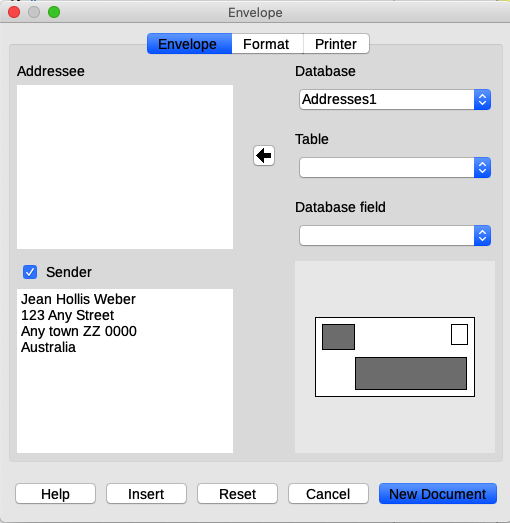
3) On the Format tab (Figure 15), verify or edit the positioning of the addressee and the sender information. The preview area on the lower right illustrates your choices.
Figure 15: Choosing positioning and size of elements for an envelope
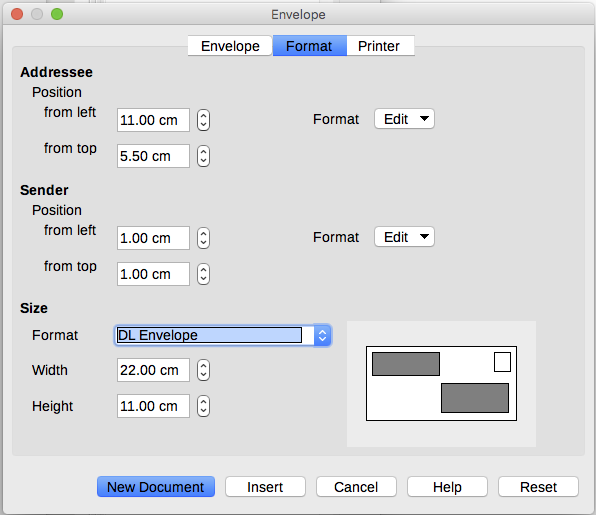
4) To format the text of these blocks, click the Edit button to the right. In the drop-down list you have two choices: Character and Paragraph.
Select Character to open a dialog similar to the standard Character dialog, where you can set the formatting of the text.
Select Paragraph to open a dialog similar to the standard Paragraph dialog, where you can set the paragraph's attributes.
5) In the lower left of this tab is the Size section. Choose the envelope format in the drop-down list. The width and height of the selected envelope are shown in the boxes below the selected format. If you chose a pre-existing format, just verify these sizes. If you chose User Defined in the Format list, then you can edit the sizes.
6) After formatting, go to the Printer tab (Figure 16) to choose which printer to use, setup (for example, specification of the tray holding envelopes), and other printer options such as envelope orientation and shifting. You may need to experiment to see what options work best for your printer and how the envelopes need to be positioned in the printer.
Figure 16: Choosing printer options for an envelope
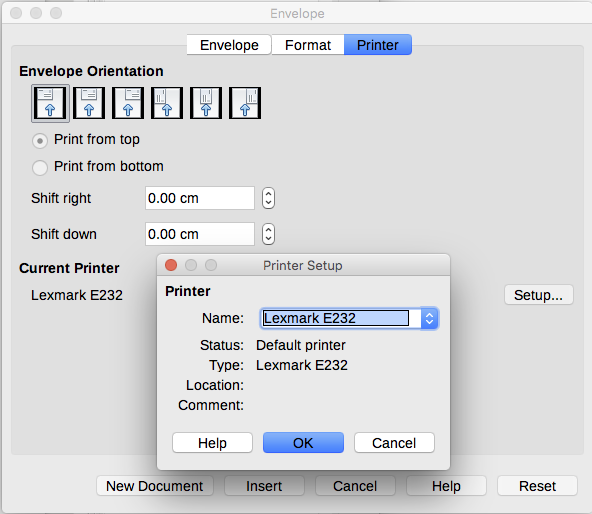
7) When you have finished formatting and are ready to print, click either New Document or Insert to finish. New Document makes only an envelope or starts a new document with the envelope. Insert puts the envelope into your existing document as page 1.
8) Save this file before you do anything else.
To print the envelope:
1) Choose File > Print on the Menu bar.
2) [Windows and Linux] On the Print dialog (Figure 2 on page Figure 2), under Range and Copies, choose Pages and type 1 in the box. Choose the required printer (which may be different from the usual printer).
[macOS] On the Print dialog (Figure 5 on page Figure 5), in the upper section of the dialog, choose Pages – From: and type 1 in both boxes.
3) Click Print.
Labels are commonly used for printing address lists (where each label shows a different address), but they can also be used to make multiple copies of one label, for example return-address stickers, labels for CDs/DVDs, or other items.
Printing labels, like printing envelopes, has two steps: setup and printing. This topic is covered in detail in Chapter 14, Mail Merge.
LibreOffice can export documents to PDF (Portable Document Format). This standard file format is ideal for sending the file to someone else to view using Adobe Reader or other PDF viewers.
Warning
A document in PDF format is not protected against contents tampering or editing by default. The PDF document contents can be edited by specialized software tools, including LibreOffice Draw.
Tip
Unlike Save As, the Export command writes a copy of the current document in a new file with the chosen format, but keeps the current document and format open in your session.
Click the Export Directly as PDF icon on the Standard toolbar, or File > Export As > Export Directly as PDF, to export the entire document using the PDF settings you most recently selected in the PDF Options dialog. You are asked to enter the file name and location for the PDF, but you do not get a chance to choose a page range, the image compression, or other options.
For more control over the content and quality of the resulting PDF, use File > Export as > Export as PDF. The PDF Options dialog opens. This dialog has six tabs (General, Initial View, User Interface, Links, Security, and Digital Signatures). Select the appropriate settings, and then click Export. Then you are asked to enter the location and file name of the PDF to be created, and click Save (Windows and Linux) or Export (macOS) to export the file.
Note
You can also export to PDF with File > Export. On the Export dialog, select the PDF file format, the file name and location, and click Save or Export. The PDF Options dialog then opens. Select the appropriate settings and then click Export. The only difference between the two export methods is the sequence of steps.
On the General tab (Figure 19), you can choose which pages to include in the PDF, the type of compression to use for images (which affects the quality of images in the PDF), and other options.
Figure 17: General tab of PDF Options dialog
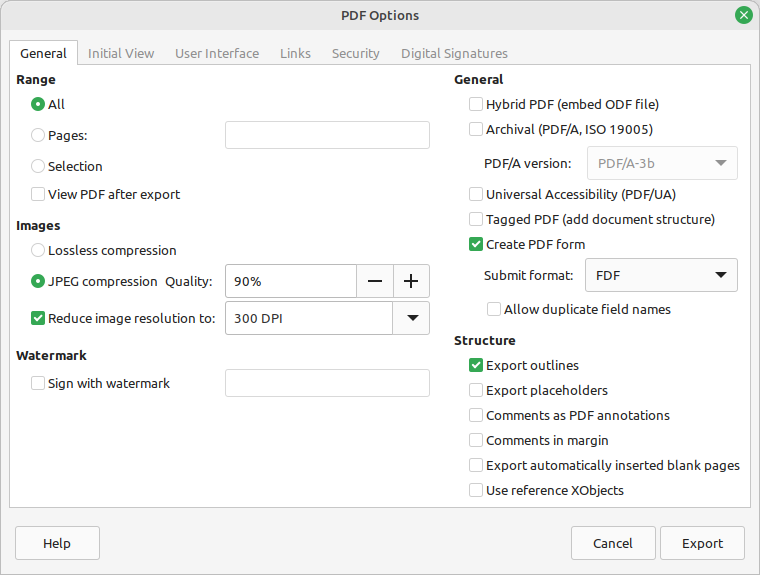
All: Exports the entire document to PDF.
Pages: To export a range of pages, use the format 3-6 (pages 3 to 6). To export single pages, use the format 7;9;11 (pages 7, 9 and 11). You can also export a combination of page ranges and single pages, by using a format like 3-6;8;10;12.
Selection: Exports whatever material is selected.
View PDF after export: Your default PDF viewer will open and display the newly exported PDF.
Lossless compression: Images are stored without any loss of quality. Tends to make large files when used with photographs. Recommended for other kinds of images.
JPEG compression: Allows for varying degrees of quality. A setting of 90% works well with photographs (smaller file size, little perceptible loss of quality).
Reduce image resolution: Lower DPI (dots per inch) images have lower quality. Lower resolutions (100 dpi or less) may be sufficient for viewing on a computer screen, but many modern devices have much higher resolutions; and for printing it is generally preferable to use at least 300 or 600 dpi, depending on the capability of the printer. Higher DPI settings increase the size of the exported file.
Note
EPS (Encapsulated PostScript) images with embedded previews are exported only as previews. EPS images without embedded previews are exported as empty placeholders.
Watermark section
Sign with Watermark: When this option is selected, a transparent overlay of the text you enter into the watermark text box will appear on each page of the PDF.
General section
Hybrid PDF (embed ODF file): Use this setting to export the document as a PDF containing two file formats: PDF and ODF. In PDF viewers it behaves like a normal PDF file, and it remains fully editable in LibreOffice.
Archive (PDF/A, ISO 19005): PDF/A is an ISO standard for long-term preservation of documents, by embedding all the information necessary for faithful reproduction (such as fonts) while forbidding other elements (including forms, security, and encryption). PDF tags are written. PDF/A-1b refers to the minimum compliance level with PDF/A-1. PDF/A-2b is recommended for most users, because it allows layers and transparency with shapes and images. It also compresses better, usually producing smaller files. PDF/A-3b is identical to PDF/A-2b, but also accepts embedding of other file formats.
Universal Accessibility (PDF/UA): Creates a universal accessibility-complaint PDF file that follows the requirements of PDF/UA (ISO 14289) specifications. When this option is selected, clicking Export causes a Warning dialog to pop up if the document contains accessibility issues. See the Help and “Accessibility checking” on page 1.
Tagged PDF: Tagged PDF contains information about the structure of the document’s contents. This can help to display the document on devices with different screens, and when using screen reader software. Some tags that are exported are table of contents, hyperlinks, and controls. This option can increase file sizes significantly.
Create PDF form – Submit format: Choose the format of submitting forms from within the PDF file. This setting overrides the control’s URL property that you set in the document. There is only one common setting valid for the whole PDF document: PDF (sends the whole document), FDF (sends the control contents), HTML, and XML. Most often you will choose the PDF format.
Allow duplicate field names: If enabled, the same field name can be used for multiple fields in the generated PDF file. You can enter data in the first occurrence of the named field in the PDF document and all fields with the same name will carry your entry. If disabled, field names will be exported using generated unique names.
Tip
Some Print-on-Demand and other commercial printing services require PDFs to contain NO transparency. To meet this requirement, select Archive PDF/A-1b and deselect Create PDF form.
Structure section
Export outlines: Exports headings as an outline (table of contents list) displayed by most PDF viewers, including Adobe Reader. In Writer 7.0 and earlier, these were called bookmarks.
Export placeholders: The PDF will include any defined placeholder fields, which can be filled in by users.
Comments as PDF annotations: Comments are included in the PDF as annotations.
Comments in margin: Page contents are reduced in size, leaving space for comments to be printed in the margin of the pages. If the document contains no comments, this option has no effect.
Export automatically inserted blank pages: If selected, automatically inserted blank pages are exported to the PDF. This is best if you are printing the PDF double-sided. For example, books usually have chapters set to always start on an odd-numbered (right-hand) page. When the previous chapter ends on an odd page, Writer inserts a blank page between the two odd pages. This option controls whether to export that blank page.
Use reference XObjects: Reference XObjects enable one PDF file to import content from another. More information can be found in section 8.10.4 of the PDF specification, ISO 32000-2:2017 (https://www.iso.org/standard/63534.html). If you are not familiar with reference XObjects, leave this box unchecked.
On the Initial View tab (Figure 18), you can choose how the PDF opens by default in a PDF viewer. The selections should be self-explanatory.
If you have Complex Text Layout enabled (in Tools > Options > Language settings > Languages), an additional selection is available under the Continuous facing option: First page is left (normally, the first page is on the right when using the Continuous facing option).
Figure 18: Initial View tab of PDF Options dialog
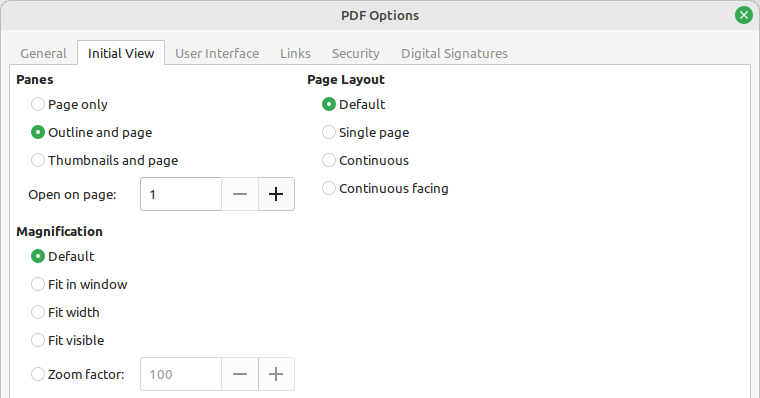
On the User Interface tab (Figure 19), you can choose more settings to control how a PDF viewer displays the file. Some of these choices are particularly useful when you are creating a PDF to be used as a presentation or a kiosk-type display.
Window options section
Resize window to initial page. The PDF viewer window will resize to fit the first page of the PDF.
Center window on screen. The PDF viewer window will be centered on the computer screen.
Open in full screen mode. The PDF viewer will open full-screen.
Display document title. The PDF viewer will display the document’s title (as recorded in File > Properties) in the title bar.
Figure 19: User Interface tab of PDF Options dialog
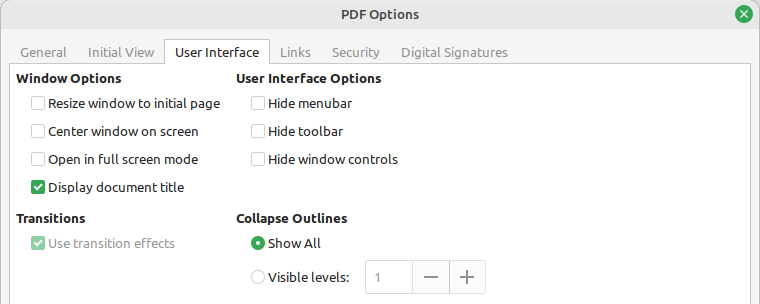
User interface options section
Hide menubar. The PDF viewer will hide the Menu bar.
Hide toolbar. The PDF viewer will hide the toolbar.
Hide window controls. The PDF viewer will hide other window controls.
Transitions
Collapse Outlines
On the Links tab (Figure 20), you can choose how links in documents are exported to PDF.
Figure 20: Links tab of PDF Options dialog
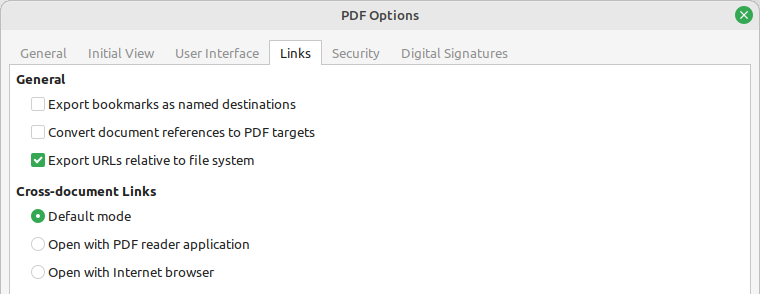
Export bookmarks as named destinations
Convert document references to PDF targets
Export URLs relative to file system
Cross-document links
Default mode: The PDF links will be handled as specified in your operating system.
Open with PDF reader application: Use the same application used to display the PDF document to open linked PDF documents.
Open with Internet browser: Use the default Internet browser to display linked PDF documents.
PDF export includes options to encrypt the PDF (so it cannot be opened without a password) and apply some digital rights management (DRM) features.
With an open password set, the PDF can only be opened with the password. Once opened, there are no restrictions on what the user can do with the document (for example, print, copy, or change it).
With a permissions password set, the PDF can be opened by anyone, but its permissions can be restricted (Figure 21). After you set a password for permissions, the other choices on the Security page become available.
With both the open password and permission password set, the PDF can only be opened with the correct password, and its permissions can be restricted.
Figure 21: Security tab of PDF Options dialog with Permissions password set
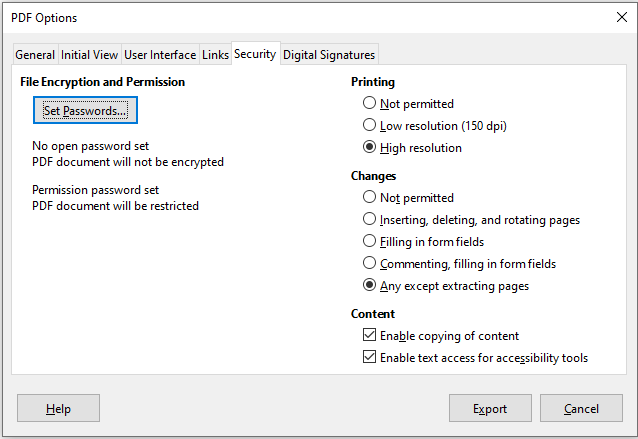
Note
Permissions settings are effective only if the user’s PDF viewer respects the settings.
The Digital Signatures tab (Figure 22) contains the options for exporting a digitally signed PDF.
Digital signatures are used to ensure that the PDF was really created by the original author (that is, you), and that the document has not been modified since it was signed.
The signed PDF export uses the keys and X.509 certificates already stored in your default key store location or on a smartcard. The key store to be used can be selected under Tools > Options > LibreOffice > Security > Certificate Path (Linux) or LibreOffice > Preferences > Security > Certificate Path (macOS). [On Windows, LibreOffice uses the default Windows location for storing and retrieving certificates.]
When using a smartcard, it must already be configured for use by your key store. This is usually done during installation of the smartcard software. Details about using these features is outside the scope of this chapter.
Figure 22: Digital Signatures tab of PDF Options dialog
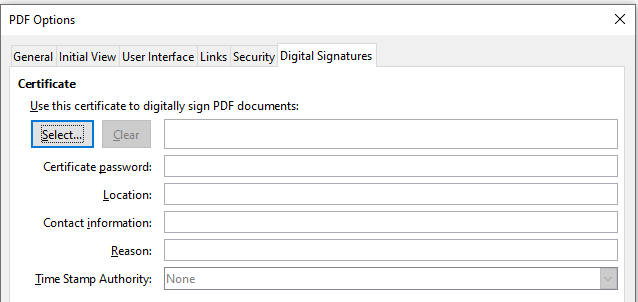
Use this certificate to digitally sign PDF documents: Click Select to open the Select Certificate dialog, where all certificates found in your selected key store are displayed. If the key store is protected by a password, you are prompted for it. When using a smartcard that is protected by a PIN, you are also prompted for that.
Select the certificate to use for digitally signing the exported PDF, then click Sign.
All other fields on the Digital Signatures tab are accessible only after a certificate has been selected.
Certificate password: Enter the password used for protecting the private key associated with the selected certificate. Usually this is the key store password. If the key store password has already been entered in the Select Certificate dialog, the key store may already be unlocked and not require the password again.
When using a smartcard, enter the PIN here. Some smartcard software will prompt you for the PIN again before signing.
Location, Contact information, Reason: Optionally enter additional information about the digital signature that will be applied to the PDF. This information will be embedded in the appropriate PDF fields and will be visible to anyone viewing the PDF. Any or all of the three fields may be left blank.
Time Stamp Authority: Optionally select a Time Stamping Authority (TSA) URL. During the PDF signing process, the TSA will be used to obtain a digitally signed timestamp that is then embedded in the signature. Anyone viewing the PDF can use this timestamp to verify when the document was signed.
The list of TSA URLs that can be selected is maintained under Tools > Options > LibreOffice > Security > TSAs. If no TSA URL is selected (the default), the signature will not be timestamped, but will use the current time from your local computer.
EPUB format has become popular since mobile devices such as smartphones, tablets, and e‑readers appeared on the market. The EPUB format is implemented as an archive file consisting of HTML files carrying the content, along with images and other supporting files.
Writer can export a file to EPUB. A text-only document generally exports well, but some contents (such as illustrations, tables, and cross-references) may not export correctly.
Choose File > Export As > Export Directly as EPUB to export the entire document using the EPUB settings you most recently selected on the EPUB Export dialog (Figure 23). Enter the file name and location for the EPUB file; you do not get a chance to select other options.
For more control over the content and quality of the resulting EPUB file, use File > Export As > Export as EPUB. The EPUB Export dialog opens (Figure 23).
Figure 23: EPUB Export dialog
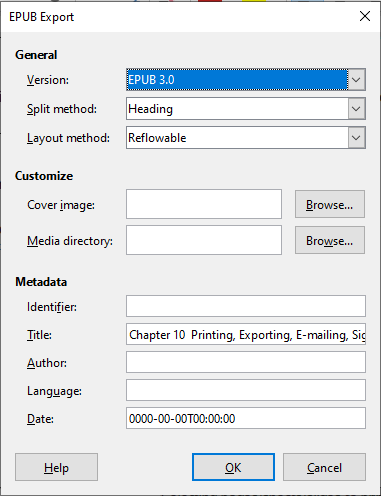
Version
Split method
Layout method
Customize – Cover image
Customize – Media directory
Metadata
Tip
Other ways to export to EPUB from Writer (.odt) files include Calibre, an open-source e‑book manager that runs on Windows, macOS, and Linux. Calibre provides many e‑book conversion facilities and allows editing of the result.https://calibre-ebook.com/
LibreOffice uses the term “export” for some file operations involving a change of file type. If you cannot find what you want under File > Save As, look under File > Export as well. Writer can export files to XHTML, EPUB and other formats, as shown in Figure 24.
Choose File > Export. On the Export dialog, specify a file name for the exported document, then select the required file format and click Export.
Figure 24: Export file formats

LibreOffice provides several ways to quickly and easily send a Writer document as an email attachment in one of three formats: .odt (OpenDocument Text, Writer’s default format), .docx (Microsoft Word format), or .pdf.
To send the current document in .odt format, choose:
1) File > Send > Email Document, or File > Send > Email as OpenDocument Text. Writer opens your default email program (if installed). The document is attached to a new email.
2) In your email program, enter the recipient, subject, and any text you want to add, then send the email.
If you choose Email as Microsoft Word, Writer first creates a file in Word format (.docx) and then opens your email program with the Word file attached to a new email. Similarly, if you choose Email as PDF, Writer opens the PDF Options dialog where you can select the settings you want, then creates a PDF, and then opens your email program with the PDF attached to a new email.
To email a document to several recipients, you can use the features in your email program or you can use Writer’s mail merge facilities to extract email addresses from an address book.
You can use Writer’s mail merge to send email in two ways:
Use the Mail Merge Wizard to create the document and send it.
Create the document in Writer without using the Wizard, then use the Wizard to send it.
See Chapter 14, Mail Merge, for details.
To sign a document digitally, you need a personal key, also known as a certificate. A personal key is stored on your computer as a combination of a private key, which must be kept secret, and a public key, which you add to your documents when you sign them. You can get a certificate from a certification authority, which may be a private company or a governmental institution.
When you apply a digital signature to a document, a checksum is computed from the document’s content plus your personal key. The checksum and your public key are stored with the document.
When someone later opens the document on any computer with a recent version of LibreOffice, the program will compute the checksum again and compare it with the stored checksum. If both are the same, the program will signal that you see the original, unchanged document.
In addition, the program can show you the public key information from the certificate. You can compare the public key with the public key that is published on the web site of the certificate authority. Whenever someone changes something in the document, this change breaks the digital signature.
For a more detailed description of how to get and manage a certificate, and signature validation, see the LibreOffice Help.
A signed document shows an icon in the Status bar. You can double-click the icon to view the certificate. More than one signature can be added to a document.
Changing an existing description invalidates the signature. However, multiple signatures from the same author are allowed, because each signature can have a different description.
The following procedure is an example of how to digitally sign a document. The actual procedure depends on how your computer is set up and its operating system.
1) Choose File > Digital Signatures > Digital Signatures.
If you have set LibreOffice to warn you when the document contains comments or recorded changes (see “Removing personal data” on page 1), you may see a message box asking whether you want to continue signing the document.
If you have not saved the document since the last change, a message box appears. Click Yes twice: once to continue and again to save the file.
2) The Digital Signatures dialog (Figure 25) opens. It lists existing signatures together with their description (if they have any). Click the Sign Document button to add a new signature to the document.
Figure 25: Digital signatures dialog
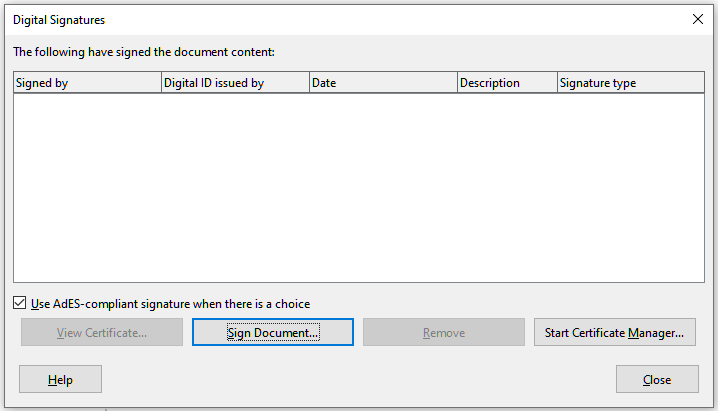
3) In the Select Certificate dialog (Figure 26), select your certificate, add an optional description, and click Sign to return to the Digital Signatures dialog. The certificate used is displayed in the dialog with an icon next to its name. This icon indicates the status of the digital signature.
Figure 26: Select Certificate dialog
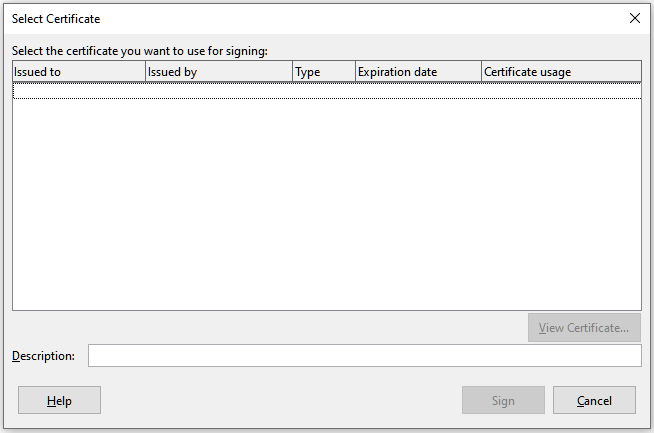
4) Click Close in the Digital Signatures dialog to apply the digital signature.
You can generate a graphic box representing a signature line using Insert > Signature Line (see Figure 27), and you can optionally sign the signature line using a digital certificate.
Figure 27: Creating a signature line for a document
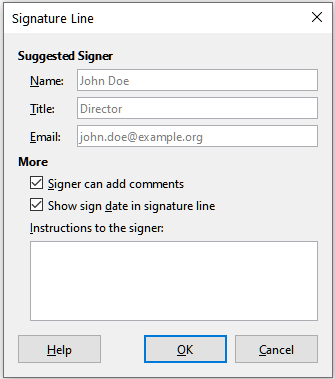
Figure 28: Signature line example

You may wish to ensure that personal data, versions, comments, hidden information, or recorded changes are removed from files before you send them to other people or create PDFs from them.
In Tools > Options > LibreOffice > Security, (macOS: LibreOffice > Preferences > LibreOffice > Security) click the Options button to display a dialog (Figure 29) where you can set LibreOffice to warn you when files contain certain information and/or automatically remove personal information on saving. These warnings appear in a bar above the document; in earlier versions of LibreOffice, the warnings were in a pop-up dialog.
To remove personal and some other data from a file, go to File > Properties. On the General tab, uncheck Apply user data and click the Reset Properties button. This removes any names in the created and modified fields, deletes the modification and printing dates, and resets the editing time to zero, the creation date to the current date and time, and the version number to 1.
To remove version information, either (a) go to File > Versions, select the versions from the list and click Delete, or (b) use Save As and save the file with a different name.
Figure 29: Set security options and warnings
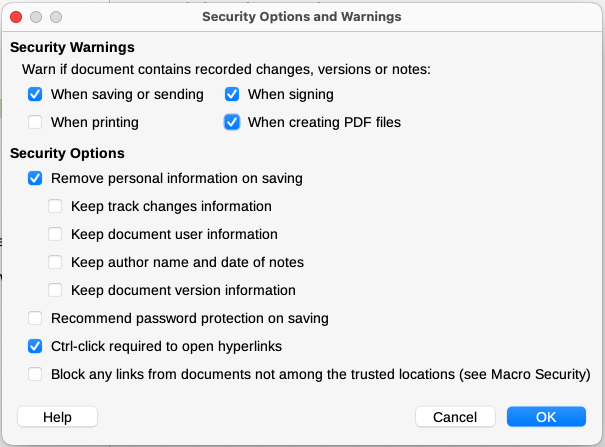
You can redact documents to remove or hide sensitive information, to allow the selective disclosure of information in a document while keeping other parts of the document secret. For example, when a document is subpoenaed in a court case, information not specifically relevant to the case at hand is often redacted.
To redact a document:
1) Open the document in Writer.
2) Click Tools > Redact on the Menu bar, and wait for the document to be prepared for redaction and transferred to Draw. The Redaction toolbar (Figure 30) opens.
Figure 30: Redaction toolbar
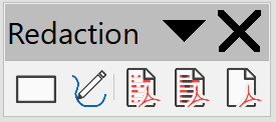
3) Do the redaction by using the Rectangle Redaction and Freeform Redaction tools on the Redaction toolbar. The shapes will be transparent and in gray so you can see what you are redacting.
4) Optionally use the Export Directly as PDF tool to make an in-redaction copy of the document in PDF to use as a verbatim copy for review. The redacted items will be in transparent gray.
5) To finalize the redaction, select the desired option (black or white) on the Redacted Export tool. The transparent grey shapes are converted to opaque black or white shapes and the document is exported as a pixellized PDF. There will be no selectable text in it, and the redacted content will be non-existent.
To partially automate the redaction process, you can define certain words (such as names) to be redacted wherever they are found in the document. To do this, choose Tools > Auto-Redact on the Menu bar to open the Automatic Redaction dialog (Figure 31). Here you can load a list of terms (targets), add targets, delete targets, edit targets, and save a list of targets.
Figure 31: Automatic Redaction dialog
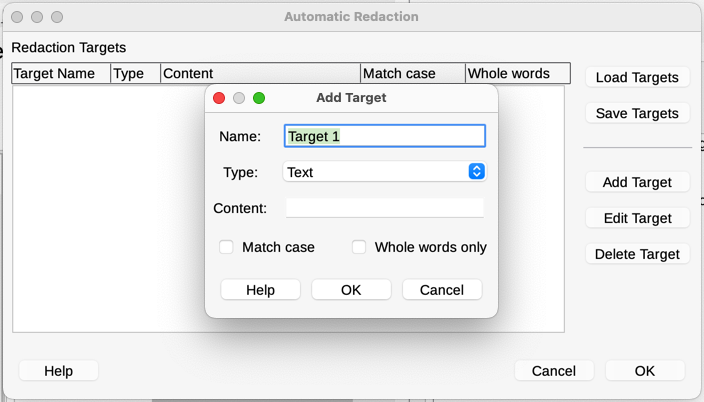
LibreOffice includes several accessibility features, including support for external devices and applications including screen readers.
Before publishing a document, you can use Writer’s Accessibility Check tool to review common problems. To run the check manually, choose Tools > Accessibility Check on the Menu bar. When exporting to PDF, selecting Universal Accessibility (PDF/UA) on the General tab of the PDF Export dialog (Figure 17) and clicking Export pops up a Warning dialog (Figure 32).
Figure 32: Warning dialog for accessibility issues

The Accessibility Check results are displayed by default in the Sidebar (Figure 33), which shows a list of all issues found in the document. The checks include:
The document title is set.
The document language is set, or that all styles in use have the language set.
All images, graphics, OLE objects have alternative (or title, in some cases) text.
Tables do not include split or merged cells.
Manual numbering (not using integrated numbering). For example writing “1.” “2.” “3.” at the beginning of the paragraphs.
Contrast between text and the background.
Footnotes and endnotes, which should be avoided.
Heading order: headings must not skip a level (for example Heading 1 to Heading 3, skipping Heading 2).
Click the Fix button to jump to the page and select the object or issue that requires attention for accessibility.
Figure 33: Accessibility Check dialog
